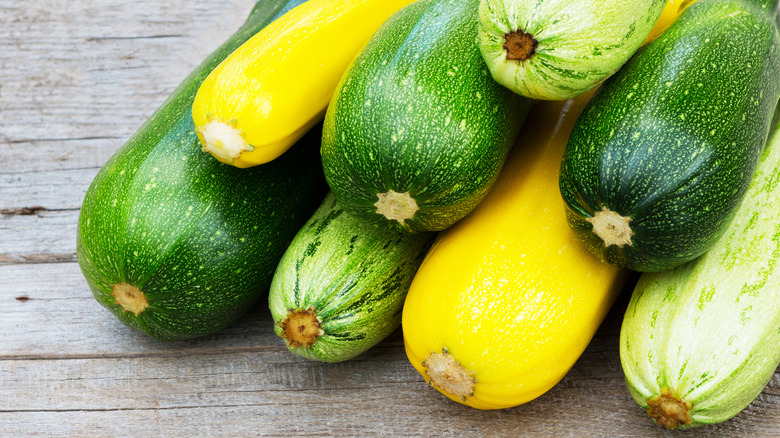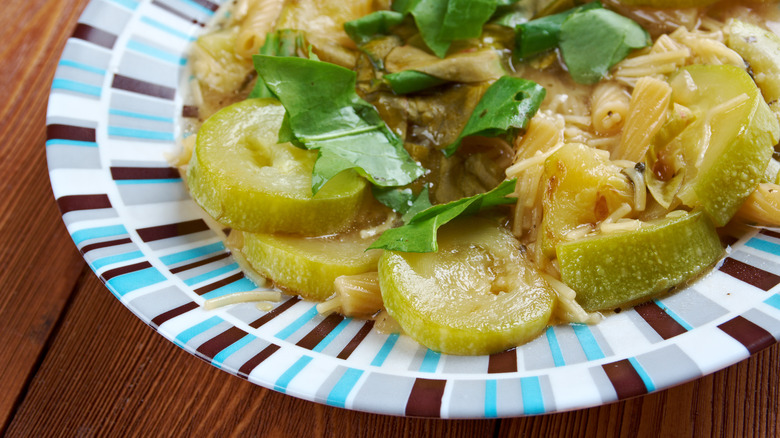The Best Methods For Avoiding Soggy Zucchini
The humble zucchini isn't exactly a shining star among its vegetable brethren. Apart from the recent zoodle-phenomenon, the zucchini (or courgette if you hail from across the pond) is rarely the star of the meal. And few Americans would consider it a staple that regularly appears on their weekly shopping lists.
If you are a zucchini devotee and these seemingly anti-zucchini proclamations are inspiring your wrath, you may be surprised by the following facts. When YouGovAmerica conducted a survey to learn America's most loved vegetables, the zucchini came in a rather sad 38th place, faring worse than cauliflower and the pinto bean. Yes, the pinto bean. Fox News revealed that a study by OnePoll showed that this lengthy green veggie garnered the eighth spot among America's most hated with only 18% admitting they liked zucchini.
This lack of popularity may not be zucchini's fault. The Washington Post posits that if you don't like zucchini, the problem may actually be the way you are cooking it. After all, the zucchini has the propensity to be mushy if prepared incorrectly. Here are some ways to avoid this problem and, maybe, win over some new fans of this versatile squash.
Zucchini is 90% water
If you've only been subjected to mushy zucchini, no one can blame you for being turned off. After all, Inspiralized confesses that this veggie is 90% water and must be cooked with this excessive moistness in mind. Employ the wrong method and — poof — you've got a pile of washed-out-green slabs of glop on your plate. This is likely why this vegetable often gets relegated to zucchini bread. Thankfully, chefs have mastered ways to prepare zucchini without transforming it into slop or using it as a baked good ingredient.
While the easiest way to enjoy a crisp slice is to eat it raw, this vegetable can be cooked while maintaining its texture. One of the first recommendations involves selecting the right zucchini. Cook's Country warns that the bigger it is, the higher its concentration of water. By selecting a smaller zucchini, you will have to contend with less moisture. Another wise step, according to BuzzFeed is to salt your zucchini after you cut it up. They suggest salting the pieces well and swaddling them in a paper towel. Keep them wrapped up for between 10 and 15 minutes, changing the paper towel as needed.
Now that you've prepped your zucchini, how can you cook it without transforming it into mush?
The zucchini responds well to roasting
A great way to avoid mushy zucchini is to roast it. Well Plated offers that it's best to cut the zucchini into large pieces like spears to avoid over-cooking. They recommend not overcrowding your zucchini, so they cook evenly. It's also suggested to raise the zucchini by putting it on a baking rack that rests on top of your baking sheet. This will enable all sides of your spears, rounds, or chunks to cook, helping remove water all over.
What if you're making zucchini noodles (a.k.a. zoodles)? Inspiralized offers that you should cook your noodles before adding your sauce to allow some of the zucchini's moisture to evaporate first. They also recommend cooking for a mere three to five minutes until they are just al dente, adding that you should drain them in a colander before adding your sauce. And, don't forget to keep the zoodles moving when you're cooking them, so they cook evenly. According to Real Simple Good, you can also use the microwave. Simply heat them for a minute. If they're not ready, keep adding 30-seconds until they're perfect.
If you've always viewed the zucchini as more foe than friend, these tips may make you a convert. With your newfound knowledge, you may want to tackle roasted zucchini with maple tahini and pistachios or some zucchini boats.


